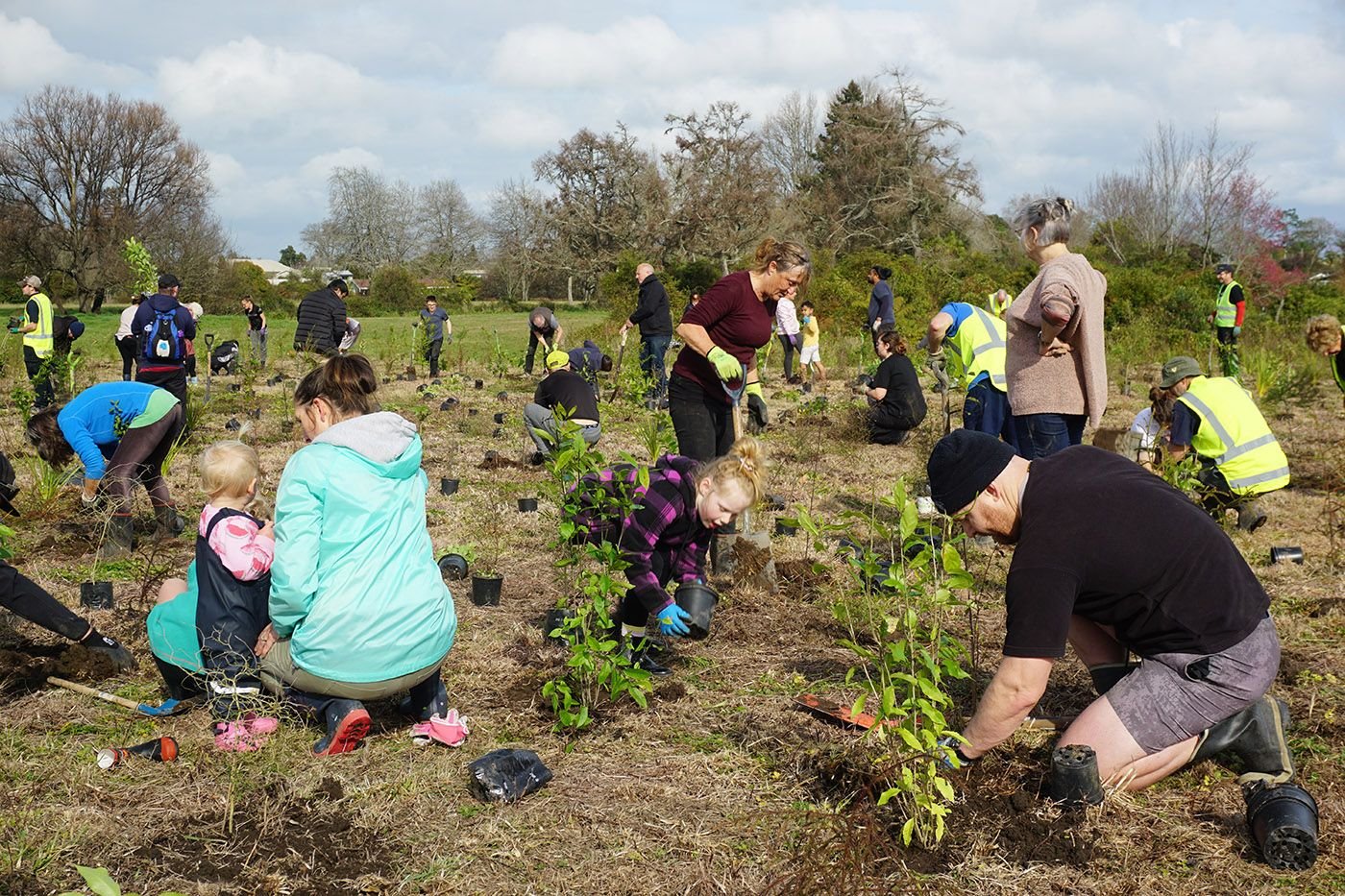OUR PLACE
There are several stories from Ngaati Wairere about Kukutaaruhe, as it was an abundant area for resources. These narratives speak of the history, and the biodiversity of the past, and inspire our vision for the future of the Kukutaaruhe Gully.
The vision of the Fairfield Project, Ngaati Wairere and the wider community is for the gully to be restored - to become an ecosystem that recreates the biodiversity of old. The project offers the community a taste of nature within the city. This place is for learning; fostering well-being and developing a sense of connection to both the natural environment and its rich cultural history.
With this vision in mind, a significant gully restoration programme began in 2017, which has involved hundreds of volunteers offering their time: preparing, planting and maintaining 31,000 plants (to date). The plants have been eco-sourced locally, and chosen specifically in order to ultimately restore the historical biodiversity of this whenua.
The Story of Kukutaaruhe
The name itself speaks to Maatauranga Maaori of old, as it depicts the flight of the kuukuu, otherwise known as the kereruu, kuukuupaa, or native wood pigeon (Hemiphaga novaseelandiae). The kuukuu was prized for its value as a food source, and as a seasonal indicator, as well as the feathers being utilized for adornment. The name Kukutaaruhe therefore symbolizes the kuukuu being a steady and observed resource of olden times.
In Ngaati Wairere’s maatauranga, the name reflects not only their observation of the kuukuu’s flight but also their knowledge of the seasons; migration patterns; native flora/fauna and their patterns; the river/stream ecology, as well as weather movements. The combination of all this maatauranga (knowledge) indicated to them the opportunity to plan, forecast, prepare and execute a management strategy to ensure the best way forward taking into account hapuu/community needs, ecological sustainability, shared resources and (needs of) successive generations.
There are also 2 large ancient Paa sites of great significance to Ngaati Wairere - Tuupari and Te Inanga.
An added value of the Kuukuu to Ngaati Wairere stems from a story of the local ancient Paa site Te Parinui. A raiding party of Ngaati Maahuta attempted to ambush Hamua and his tribe in bypassing the river and stealthily creeping through the gully to attack from behind, but their efforts were thwarted when the noise they made startled the Kuku who all took flight, alerting Ngaati Wairere of the raiding party and enabling them to defend the area and see the attackers off.
Biodiversity
The Kukutaaruhe Gully is typical of many urban gullies in the Hamilton Ecological District. The Gully comprises a small but diverse ecosystem that includes several vegetation ecotypes.
The gully was typical of a farmed landscape that was followed by urban development. As such it was ecologically degraded, provided limited habitats and had been invaded by pest plants and exotic mammals and birds. This led to reduced amenity values (both cultural and social).
Nevertheless there are still significant habitat values and some diversity of indigenous species present, which is being enhanced by the restoration work underway:
The stream once supported a range of emergent aquatic macrophytes and provided habitat for tuna, native fish (mainly Galaxiid species), kooura and freshwater mussels. Currently, the stream biodiversity includes:
Giant Kookopu - these fish spawn on the gully streambanks and are considered to be nationally vulnerable. This gully is unique, as it is the only site on mainland New Zealand where spawning has been observed. NIWA have been studying this population for over 15 years.
Both long and short fin tuna (eel) species are resident in the stream.
Stream macroinvertebrates - these indicate a surprisingly good water quality, considering the urban setting and the amount of stormwater run-off into the stream.
The forests and wetland originally supported a large range of native birds, lizards (both gecko and skinks) and the pekapeka-tou-roa (long-tailed bat). The narratives of Ngaati Wairere tell of large numbers of kuukuupaa (kereruu) flying through the gully in pre-European times. The terrace scarps and steep banks would have been covered with forest dominated by tootara, mataii, and koowhai as well as kaanuka and kaamahi.
The poorly-drained gully floor was dominated by kahikatea, pukatea, swamp maire, tii koouka, and pookaakaa.
Wetlands associated with the stream margins included kahikatea swamp forest with maanuka, harakeke, and emergent raupoo, spike rush, twig rush, and club rush.
There are a small number of remnant indigenous plant species still present and in adjacent Donny Park there is an identified Significant Natural Area (SNA) of remnant raupoo wetland.
Current terrestrial animal and bird species (ie not freshwater species) in the gully include:
Tuuii and ruuruu are nesting
Kaakaa are regular seasonal visitors
Piiwaiwaka are regularly seen
Kaarearea (NZ Falcon) and kaahu (Harrier hawk) have been sighted
Mokomoko (Copper skink) and weetaa are seen regularly
There has been at least one record of a commuting long-tailed bat visiting.
Many weed and pest animal species have been identified through our monitoring programmes and a more systematic Predator-Free monitoring and trapping programme was launched in 2022 to respond to this problem and over 500 rats have been removed from the gully to date.
The gully and surroundings are used as one of our key educational contexts, both informally and through provision of workshops and school programmes.


